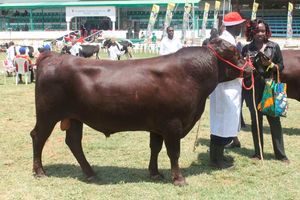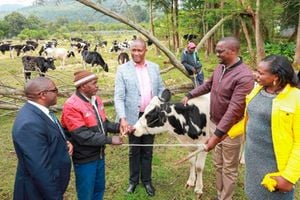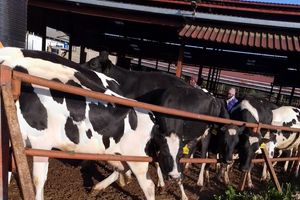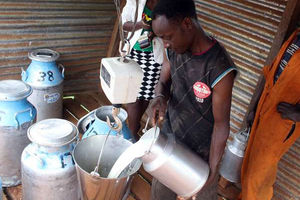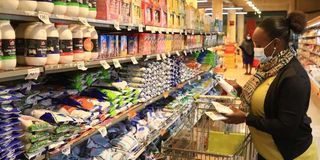
Milk at a supermarket. Processors say drop in prices is due to oversupply and influx of cheap imports.
My work is cut out as the year progresses. There are issues that will greatly define my professional activities. I closed 2019 with a challenge to identify a disease that affected a pig farm in Kiambu. Bringing out the case encouraged farmers to report outbreaks that fit the definition for African swine fever (ASF). I have passed these reports to relevant authorities and will want to know if the disease was confirmed and control measures implemented.
It has also become clear there are animal health service providers who advise farmers to sell ASF pigs for slaughter and consumption. This is definitely keeping the disease in circulation, especially in Nairobi and Kiambu.
Those providing this advice must revisit the science of good pathogen management. Pathogens specific to a host should not be repeatedly exposed to another species to minimise the risk of adaptation to infect the new species. People should not be deliberately exposed to the ASF virus.
I am surprised by one farmer in Nairobi who has relentlessly engaged me via e-mail. He says the disease cannot be controlled and the restriction of sale of sick pigs for human slaughter is meant to impoverish farmers. The disease has cleared his pigs on two occasions in the last 20 years. I empathise with the farmer because Kenya has no compensation policy for animals destroyed due to disease control. This is an area where I will be working to encourage the government to develop and implement compensation regulations for animals destroyed during disease outbreaks.
Second, some have asked if livestock farming is inherently meant to be risky. Like other businesses, farming has its fair share of challenges. The challenges are enhanced because farmers deal with biological assets with an expiry date that is prematurely sensitive to many factors.
While one can mitigate the impact of undesirable events in livestock farming, some events occur unexpectedly with devastating outcomes. Many farmers lack sufficient knowledge to determine the interventions that could easily result in reduction of production costs.
A case in point is the ASF outbreaks that started in 2016 and continues. Farmers, especially in Kiambu, Murang’a and Kajiado counties lost heavily and others are still registering outbreaks.
Anne from Ruai, for instance, says she lost all her pigs two weeks ago and is planning to restock after six months. She does, however, not know if the virus would still be on the farm.
Another event is the foot and mouth disease (FMD) currently live in several counties. I was surprised to read in a daily that some farmers are using traditional brews, especially busaa, to try to cure FMD in their cattle.
I urge farmers to follow up on the articles I will publish to help them understand and practise beneficial disease control strategies. FMD, for instance, is effectively controlled by vaccinating the animals two times a year with a high quality drug containing strains of the virus that causes disease in a particular region.
Animals could be vaccinated every four months in areas with high disease challenge.
In Kenya, we vaccinate for four strains of the disease – A, O, SAT1 and SAT 2. The vaccine is called quadrivalent and is manufactured by the Kenya Veterinary Vaccines Production Institute (Kevevapi).
Any farmer who gets an FMD outbreak after appropriate vaccination should report to the Director of Veterinary Services, the Veterinary Medicines Directorate and Kevevapi.
The event that caused the greatest uproar with farmers last year was the impromptu reduction in the producer price of milk by major processors by about Sh10 in August.
This almost made the farm gate price of milk equal to the production cost, especially in zero grazing. The net result was that the farmer would produce milk at a loss or no profit.
We know that no one wants to invest for nothing or loss, but that is where the processors are pushing the dairy farmers. The situation is not sustainable. If unchecked, the dairy industry in Kenya could collapse. This would render hundreds of thousands of Kenyans jobless and increase the consumer price of milk.
Processors say the drop in milk prices is due to oversupply as a result of good weather and influx of cheap imports. It may be so but questions arise from the explanation. Why is milk produced from far cheaper in Kenya than locally produced milk? Why do consumer prices of processed milk remain the same even with the drop in producer prices?
A quick review of milk production and marketing in Kenya shows a number of factors that could provide answers to the farmers’ questions on the producer price. The price of processed milk in the country ranges from Sh84 to Sh110 per litre, compared to Sh17 to Sh35 for producer price.
The producer price of milk is less than a third of processed milk. Interestingly, three of the milk brands with a price range of Sh48 to Sh55 per half a litre are actually one company, making it easy for the processor to dictate the producer price.
Research by Tegemeo Institute in 2016 confirmed the same ratio of consumer to producer price per litre. The study also found that there was no data on the cost of processing a litre of milk or transparency in the setting of the producer and consumer prices.
This means the processors independently set the producer and consumer milk prices and the farmer is left at their mercy.
It is not understandable why milk prices drop when supply is high but consumer prices remain the same. It can only mean the processor makes more money at the expense of the farmer.
It is known from research that the smallholder under zero grazing farming produces 80 percent of the milk sold to processors. Discussion on milk production price should, therefore, centre on this production system.
The Tegemeo study further showed that the average cost of production of milk under zero grazing was Sh19 per litre, Sh17.2 for semi-zero grazing and Sh10 for open grazing. It added that the highest cost of production is attributed to the commercial dairy concentrate fed to cattle in zero grazing. It comprised 41.8 percent of total production cost. The other major cost was labour at 51 percent.
These costs do not vary in favourable or unfavourable weather because feeds and labour requirements remain constant all year round.
From my experience, many farmers produce milk at Sh19 to Sh25 per litre as they seek to have high producing cattle, which also require high level of care.
When the profit of dairy production was calculated – taking into account all the costs involved, as should be done with any other business – the figures were unfavourable for the farmer.
Zero grazers incurred a loss of 60 cents per litre but the semi-zero and open grazing farmers made a profit of Sh5.6 and Sh7.9 respectively.
These findings confirm the farmers’ complaints of poor returns from dairy production. They also show that the practice of processors lowering the producer cost of milk in a glut is not justified and hurts the farmer economically.
This state of affairs is not unique to dairy farmers. It cuts across the various livestock production segments, including meat and eggs.
In all situations, it is the farmer who suffers while the middle actor makes the money. I have always said the farmer should be supported and given a fair deal as she operates in one of the sectors that qualify to be patriotic duty. Farmers give us food, employment, grow the economy and conserve livestock diversity.
I urge livestock producers to engage deeply with the government and livestock products processors with a view to ensuring fair trade across the value chain, especially at the farm gate level.
Livestock farmers should organise themselves into groups like cooperatives that are able to push for enactment of good policies.
Such policies should ensure that farming promotes national food adequacy, safety and sustainable balanced development across the agrarian communities.
This can only happen if the producer pricing for livestock products is fair and transparently negotiated, taking full account of the producer cost and the need for the farmer to make profits on her investment.


